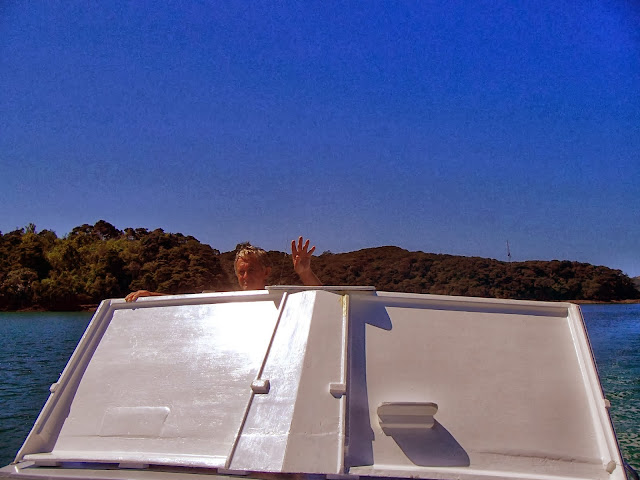Ben decided he was keen to paddle the harbour across to the Russel forest but Jen and I decided to press on via water taxi rather than wait for the favourable tide the following day. The Russel forest yielded a lot of river walking and then we had trouble finding the right track when the time came to venture back to land. The "hut" mentioned on the map was more of a camp shelter and we stayed there as we realised we wouldn't get out of the forest by dark. The following day we made our way out via a decent four wheeler track which eventually turned into thick bush.
After lunch by a creek we walked on down to the road but not before I realised I had lost a Croc in the bush having secured it to the outside of my pack. Jen suggested that Ben may find it on his way through but I was resigned to having lost it after only one river walk. It was very warm by the time we reached the end of the track, so a swim in the creek was a higher priority than walking on a busy, windy, coastal road. The water was truly bracing but welcome and we stayed there for awhile rather than taking on the long road walk ahead.
We walked on down the road for a few hours before reaching Helena Bay which Jen absolutely loved. We managed to camp at the disused school for $5 each by asking at the house next door. Then, Jen got a text from Ben reading: "I have Lance's left Croc." Trail magic really does happen. Apparently, Ben was now walking with Joe O'brien (who, incidentally, is now ridiculously far ahead of us) who spied my missing flipper amongst the undergrowth, exclaiming "that is a huge Croc!" I was really stoked and this former Croc mocker slept well in the knowledge of a safe sandal.
The following day involved a solid road walk up to a bush track that seemed to cross a couple of private properties. It was hard going toward the end and the spiders had put every web right at my face height. We pushed on down out of the bush and across a farm containing curious cows out to the road. By this stage both Jen's and my GPS had gone flat but we managed to figure out the right path to the campground at Whananaki which was pretty
good but a little pricey.
The following day we waited for Ben and Joe to join us late morning and moved out across the longest foot bridge in the southern hemisphere. We followed the path around some stunning little private beaches and through farmland on down to Matopouri where I was meeting my lovely lady to spend labour weekend in Whangarei. We were all pretty happy to be getting into a vehicle. There is no camping in Matapouri so we dropped Ben, Jen and Joe at the holiday park in Tutakaka and made our way to Whangarei for a spa at the hotel.
All photos are courtesy of Jen Wray, due to tech difficulties at the time I got no pics. Check her blog: http://jennsjourneying.blogspot.co.nz


















.jpg)






























